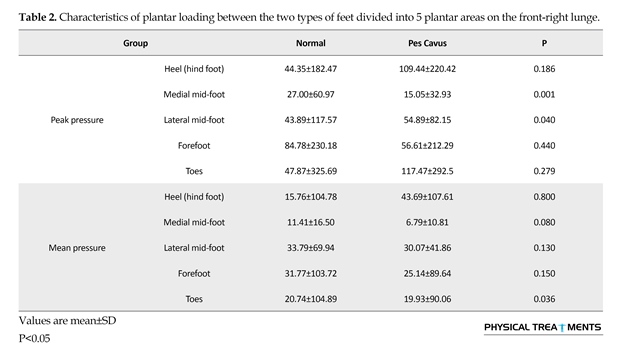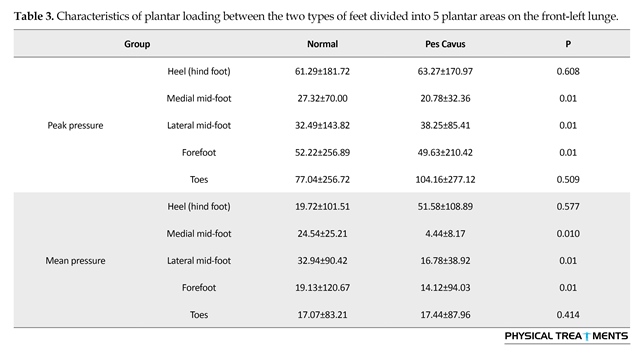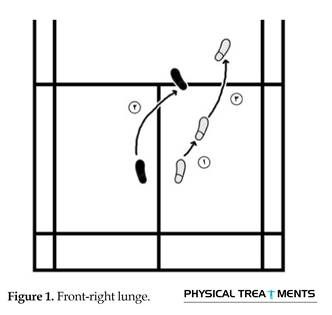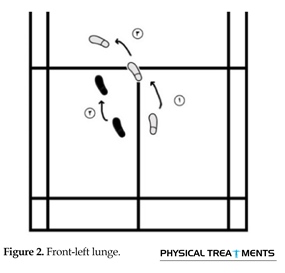BibTeX | RIS | EndNote | Medlars | ProCite | Reference Manager | RefWorks
Send citation to:
URL: http://ptj.uswr.ac.ir/article-1-301-en.html
2- Department of Occupational Therapy, School of Rehabilitation Sciences, Shiraz University of Medical Sciences, Shiraz, Iran.
3- Department of Physiotherapy, University of Social Welfare and Rehabilitation Sciences, Tehran, Iran.
4- Department of Sports Coaching, School of Physical Education and Sports Sciences, Kharazmi University of Tehran, Tehran, Iran.
1. Introduction
Many sport injuries can be treated and most people can return to a desirable level of physical activity after the applying the proper treatment, although most of such injuries can be prevented, if the essential points are considered [1]. However, some abnormalities increasing the risk of injury cannot be cured and modified, and the risk of injury can only be reduced by preventing and observing the external factors. The risk of injury in sports also depends on the exercise and the player’s position [2]. Many risk factors are reported in ankle and feet injuries, including age, gender, the skeletal posture, muscle imbalances, shoe type, level of competition, and the status of plantar arch [3].
The height increase of the plantar arch is accompanied by an increased risk of lower extremity injuries including inflammation of the plantar fascia, bone injuries such as pressures causing the formation of fracture [3], damages of the outer part such as inflammation of the greater trochanter stock, iliotibial band syndrome, or the lateral ankle sprain sector. It might also lead to increased dry and hard movement of feet, which results in the loss of shock absorbing properties, in comparison with players with the normal structure of the plantar arch [4]. Studies showed that the conditions can cause pain, fractures resulting from pressure, and disrupting the pattern force on the soles of the feet, while walking and running [5].
Sudden maneuvers of stop and moving impose many forces on the lower extremity of players, which are prone to leg injuries, especially during fast and frequent lunge that creates a lot of pressure on the back heel [6, 7]. Lunge is a movement that cannot be removed from movements of badminton players [8]. Due to the outbreak of arched plantar and sensitive feet in sports, especially in the sports which impose great force to the sole with fast speeds, it seems that injuries and their consequences can be prevented with preventive measures such as using shoes or the insole that are appropriate for sport and their structure is adequate to the distribution of forces and the player’s feet shape. Huang et al. (2014) in a study entitled “Lunge Kinetics in Four Directions” compared the kinetics lunge in 4 directions of the front-right, front-left, rear-right, and rear-left in 2 brands of badminton shoes in lunge typical maneuver. The results of the experiment showed that front-left lunge is a critical maneuver in badminton biomechanics and due to a large force created at the heel contact, it is suitable for the studies on shoes [6].
Daniel W. Carson et al. (2012) in a study entitled “Increased plantar force and impulse in American football players with high arch compared to normal arch” determined differences in plantar pressure in football players during 2 movements of walking and rotation. The results showed a difference in the pressure patterns between the players with plantar arch and the ones with normal plantar arch [4]. Habibi Tirtashi et al. (2013) in a study entitled “The effect of feet arch on compressive and shear forces of ankle joint in gait initiation” compared the shear and compressive forces of ankle in patients with flat and arched feet. The results showed a significant difference between the arched and normal feet, arched and flat feet, and also the flat and normal feet in the compressive force of the ankle joint, and the arched and flat feet, and normal and flat feet in the shear force of the ankle joint [10].
Several studies were conducted on the effects of surface features on plantar pressure, comparison of the plantar pressure imposed on the feet in different shoes, evaluation of dynamic pressures imposed on the sole feet while walking, running, cutting, jumping, and landing as well as musculoskeletal complications in the static mode and the effect of complications on postural balance [5, 11-16]. However, few studies were conducted to measure and determine the plantar pressure patterns in professional sports and the athletes. Given that the differences in foot structure such as abnormal arch doubles the risk of damage resulting from the excessive use of the lower extremity limbs; therefore, athletes with low- or high-arch feet might expose high risks for injuries in the lower extremities, compared with the athletes with normal-arch feet. Accordingly the current study aimed at comparing the plantar pressure imposed on cavus foot and normal foot in badminton athletes.
2. Materials and Methods
The population of the current study comprised of badminton players in Tehran province, Iran. The convenient sampling method was used to select the study subjects and accordingly, 10 subjects with cavovarus foot deformity and 10 subjects with normal feet without any history of trauma in the feet and ankles were recruited. All subjects signed the consent form to participate in the study. Type of athletes feet was determined using the Feet Posture Index (FPI) test and the athletes with scores 0 to 5, and 1 to 4 were considered the athletes with normal and cavus feet, respectively. Reliability and validity of FPI scale were assessed in several studies [17-21]. The internal reliability of the scale was reported 0.956 to 0.959 [22]. Subjects with cavovarus foot deformity and plantar feet in both feet were tested in the current study.
Demographic data of the subjects were recorded as follows: mean±standard deviation (SD) of age 3.34±19.3±3.34, weight 61.5±8.56, and height 173.6±10.83. Plantar loading characteristics were collected using Pedar-X® system (Germany) at a frequency of 100 Hz. Before test sessions, insoles were calibrated according to the manufacturer guidelines. Both feet size insoles of the subjects were put in their shoes. Subjects were asked to repeat 2 lunge moves (front-right and front-left lunge) (Figures 1 and 2) 5 times, while wearing badminton shoes. During the lung movements the subjects were under the pressure of the right hind feet and the results were recorded in the last step. The maximum pressure variables and those of the average pressure for all areas of the feet were analyzed.
Accordingly, the feet percentage mask was divided into 5 areas including heel, the inner side of the feet, the external side of the feet, forefeet, and toes. The current study aimed at determining the effect of plantar types on 2 basic badminton movements. To compare the 2 types of plantar feet (normal and arched), the Shapiro-wilk test was used to investigate the normality of data, and the results indicated normal distribution among all the studied variables (P>0.05). To compare the quantitative indicators in the 2 groups of cavus foot and normal foot, the independent t test was used. Data analyses were carried out using SPSS version 20; P<0.05 was considered as the level of significance.
3. Results
Subjects consisted of 10 athletes with normal arch in both feet in the control group and 10 athletes with cavovarus foot deformity in both feet in the experimental group. A significant difference was observed in demographic variables of age (P=0.530), weight (P=0.418), and height (P=0.80) between the groups (Table 1). Maximum pressures of the medial mid-foot area (P=0.001), lateral mid-foot (P=0.040), and average pressure in the fingers were significantly lower in front-right lunge of the athletes with cavovarus foot deformity than in the ones with normal feet (P=0.036). The maximum and average pressures were more observed in the heel, however, the significant between the pressures were insignificant (P>0.05) (Table 2). In the front-left lunge, maximum pressure and the average area of the medial mid-feet (P=0.010), lateral mid-feet (P=0.010) and fore-feet (P=0.010) were statistically significant in the athletes with cavovarus foot deformity, compared with the ones with normal feet. In this movement, the average pressure on the heel and maximum and average pressures on fingers were higher in people with cavovarus foot deformity, however, this difference was statistically insignificant (P>0.05) (Table 3).
4. Discussion
The current study aimed at determining the effect of foot type on the plantar loading characteristics of the feet during 2 basic badminton movements. The results of the study showed that plantar loading characteristics were affected by the foot type and the differences depended on the direction of the movements. As in all feet types, the pressure imposed on one area of the foot is changing; these changes are not similar in different directions. Based on the previous studies, plantar loading characteristics in various sports movements and different directions of lunge changes in normal subjects [2, 4, 23, 24]. The results of previous studies on effect of foot type on the risk of injury and its mechanics were contradicted and it is still unclear that which type of foot increases the risk of injury [2].
Stiffness in the mechanics of gait in people with cavovarus foot deformity indicated that too much pressure on the lateral and forefoot areas caused by muscle rigidity, excessive arch, and also the first metatarsal plantar flexion can cause pain and pressure to the forefoot, lateral area of foot, small plantar bone, sesamoid bone, and inflammation of the plantar fascia [2]. Among the subjects of the current study, the pressure imposed on beneath the mid-foot area was lower in the subjects with cavovarus foot deformity compared with the ones with normal feet in the typical Lunge maneuver implemented in 2 directions; however, the pressure imposed on beneath the forefoot was lower in front-left lunge.
Pressure imposed on the fingers in the left-front lunge was higher in people with cavovarus foot deformity than the ones with normal foot; but, the difference was insignificant. Pressure on heel in 2 directions of lunge was also higher in people with cavovarus foot deformity than the ones with normal feet, although it was statistically insignificant. The results on lower pressure imposed on mid-foot and more pressure on heels in people with cavovarus foot deformity compared with the ones with normal feet were consistent with those of a study conducted by Burns et al. (2005) [21]. The results obtained regarding the lower pressure imposed on forefoot and more pressure on heels were consistent with those of the studies conducted by Carson et al. (2012) and Habibi et al. (2013) [4, 10].
To the authors' best knowledge, the current study was the 1st one investigated the plantar loading characteristics in the professional sport movements focusing the type of plantar feet. A study by Huang et al. (2014) conducted on the kinetics of lunge in 4 directions showed that front-left lunge was a critical maneuver in badminton [25]. Based on the current study findings, the pressure imposed on the heel and toes in front-left lunge were higher in the subjects with cavovarus foot deformity compared with the ones with normal feet. Therefore, the left-front lunge can be considered a more critical maneuver to raise the risk of damages resulting from pressure imposed on fingers and heel in people with cavovarus foot deformity compared with the ones with normal feet. The way of determining the foot type and categorizing the subjects is a factor that should be considered to compare different studies. In previous studies, the type of foot or the height of the medial longitudinal arch of the foot were defined using techniques employed by clinical trials and foot print analyses. Some studies defined foot type only based on 1 parameter [2].
However, the current study attempted to prevent errors as much as possible, using FPI test based on 6 different anatomic parameters, validity of which was confirmed in previous studies [17, 18]. Previous studies showed that the employed instrument frequency of measurement, type of shoes, speed of movement, type of foot, and plantar foot can influence the amount of pressure; therefore, the data comparison regarding plantar loading characteristics beneath the foot should be done carefully among the studies [2, 12, 13]. The current study tried to minimize the differences between the study samples regading age, history of injury or foot and ankle pain, and the use of the badminton shoes.
According to the results of the study, it can be concluded that the foot arch amount as well as the type and orientation of the activities are the factors influencing the imposed pressures by plantar area and other areas under pressure. The current study had some limitations; for example, it was conducted in a lab environment and the subjects used their own shoes. The other limiting factors were lack of shear forces to the feet. Therefore, researches on athletic shoes designed for the sports with fewer restrictions, measurement of forces acting on the foot, and also pressures imposed on feet with a focus on lower limb abnormalities can be conducted.
Acknowledgements
The present paper is extracted from Ms. Parvane Bazipoor MSc. thesis, Department of Occupational Therapy, School of Rehabilitation Sciences, Shiraz University of Medical Sciences. Authors express their gratitude to all athletes of Tehran badminton team, Iran, and other people who helped to conduct the study.
Conflict of Interest
The authors declared no Conflicts of interest.
References
[1]Kondrič M, Matković B, Furjan-Mandić G, Hadžić V, Dervišević E. Injuries in racket sports among Slovenian players. Collegium Antropologicum. 2011; 35(2):413-7. PMID: 21755712
[2]Queen RM, Mall NA, Nunley JA, Chuckpaiwong B. Differences in plantar loading between flat and normal feet during different athletic tasks. Gait & Posture. 2009; 29(4):582–6. doi: 10.1016/j.gaitpost.2008.12.010
[3]Rosenbaum AJ, Lisella J, Patel N, Phillips N. The cavus foot. Medical Clinics of North America. 2014; 98(2):301–12. doi: 10.1016/j.mcna.2013.10.008
[4]Carson DW, Myer GD, Hewett TE, Heidt RS, Ford KR. Increased plantar force and impulse in American football players with high arch compared to normal arch. Foot. 2012; 22(4):310–4. doi: 10.1016/j.foot.2012.09.002
[5]Chang HW, Chieh HF, Lin CJ, Su FC, Tsai MJ. The relationships between foot arch volumes and dynamic plantar pressure during midstance of walking in preschool children. PLoS ONE. 2014; 9(4):94535. doi: 10.1371/journal.pone.0094535
[6]Hong Y, Wang SJ, Lam WK, Cheung JTM. Kinetics of badminton lunges in four directions. Journal of Applied Biomechanics. 2014; 30(1):113–8. doi: 10.1123/jab.2012-0151
[7]Robinson G, O'Donoghue P. A movement classification for the investigation of agility demands and injury risk in sport. International Journal of Performance Analysis in Sport. 2008; 8(1):127-44.
[8]Kuntze G, Mansfield N, Sellers W. A biomechanical analysis of common lunge tasks in badminton. Journal of Sports Sciences. 2010; 28(2):183–91. doi: 10.1080/02640410903428533
[9]Orlin MN, McPoil TG. Plantar pressure assessment. Physical Therapy. 2000; 80(4):399–409. doi: 10.1093/ptj/80.4.399
[10]Habibi Tirtashi F, Eslami M, Tazike Lamaski Z, Hoseinzade E. [The effect of feet arch on compressive and shear forces of ankle joint in gait initiation (Persian)]. Journal of Sport Medicine. 2013; 5(2):39-51.
[11]Witana CP, Goonetilleke RS, Xiong S, Au EYL. Effects of surface characteristics on the plantar shape of feet and subjects’ perceived sensations. Applied Ergonomics. 2009; 40(2):267–79. doi: 10.1016/j.apergo.2008.04.014
[12]Wiegerinck JI, Boyd J, Yoder JC, Abbey AN, Nunley JA, Queen RM. Differences in plantar loading between training shoes and racing flats at a self-selected running speed. Gait & Posture. 2009; 29(3):514–9. doi: 10.1016/j.gaitpost.2008.12.001
[13]Wegener C, Burns J, Penkala S. Effect of neutral-cushioned running shoes on plantar pressure loading and comfort in athletes with cavus feet: A crossover randomized controlled trial. The American Journal of Sports Medicine. 2008; 36(11):2139–46. doi: 10.1177/0363546508318191
[14]Orendurff MS, Rohr ES, Segal AD, Medley JW, Green JR, Kadel NJ. Regional foot pressure during running, cutting, jumping, and landing. The American Journal of Sports Medicine. 2008; 36(3):566–71. doi: 10.1177/0363546507309315
[15]Moeini F, Aghayari A, Mousavi SH. [The effect of functional fatigue on dynamic balance in girl students with different plantar arch (Persian)]. Journal of Sport Medicine. 2014; 6(2):131-151.
[16]Yalfani A, Amini Semiromi E, Raeisi Z. [The effect of musculoskeletal abnormalities of pes planus, pes high arch and hallix valgus on postural sways during quiet stance. (Persian)]. Journal of Sport Medicine. 2015; 7(1):143-62.
[17]Keenan AM, Redmond AC, Horton M, Conaghan PG, Tennant A. The foot posture index: Rasch analysis of a novel, foot-specific outcome measure. Archives of Physical Medicine and Rehabilitation. 2007; 88(1):88–93. doi: 10.1016/j.apmr.2006.10.005
[18]Evans AM, Copper AW, Scharfbillig RW, Scutter SD, Williams MT. Reliability of the foot posture index and traditional measures of foot position. Journal of the American Podiatric Medical Association. 2003; 93(3):203–13. doi: 10.7547/87507315-93-3-203
[19]Redmond AC. Foot posture in neuromuscular disease: Development and evaluation of a novel method for quantifying change in foot posture using Charcot-Marie-Tooth disease as a clinical model [PhD thesis]. Sydney: University of Sydney; 2004.
[20]Yates B. The incidence and risk factors in the development of medial tibial stress syndrome among naval recruits. American Journal of Sports Medicine. 2004; 32(3):772–80. doi: 10.1177/0095399703258776
[21]Burns J, Keenan AM, Redmond A. Foot type and overuse injury in triathletes. Journal of the American Podiatric Medical Association. 2005; 95(3):235–41. doi: 10.7547/0950235
[22]Terada M, Wittwer AM, Gribble PA. Intra-rater and inter-rater reliability of the five image-based criteria of the feet posture index-6. International Journal of Sports Physical Therapy. 2014; 9(2):187-94. PMCID: PMC4004124
[23]Hong Y, Wang SJ, Lam WK, Cheung JTM. Kinetics of badminton lunges in four directions. Journal of Applied Biomechanics. 2014; 30(1):113–8. doi: 10.1123/jab.2012-0151
[24]Wong P, Chamari K, Chaouachi A, Mao DW, Wisloff U, Hong Y. Difference in plantar pressure between the preferred and non-preferred feet in four soccer-related movements. British Journal of Sports Medicine. 2007; 41(2):84–92. doi: 10.1136/bjsm.2006.030908
[25]Huang MT, Lee HH, Lin CF, Tsai YJ, Liao JC. How does knee pain affect trunk and knee motion during badminton forehand lunges? Journal of Sports Sciences. 2014; 32(7):690-700. doi: 10.1080/02640414.2013.848998
Received: 2016/03/30 | Accepted: 2016/06/17 | Published: 2016/10/1
| Rights and permissions | |
 |
This work is licensed under a Creative Commons Attribution-NonCommercial 4.0 International License. |










